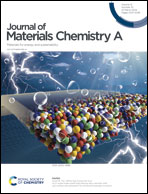Hydrogen bonds delicately restraining photoelectric performance in hybrid perovskites†
Abstract
Hydrogen bonds are ubiquitous in tetragonal methyl ammonium lead iodide (MAPbI3) hybrid perovskite and delicately restrain the photoelectric performance by regulating the octahedral distortion. To enhance photoelectric conversion, the interplay between hydrogen bonding interaction, octahedral distortion and photoelectric performance is studied by first principles calculations. Herein, based on the hydrogen bond length, the hydrogen bonds in one amine group can be divided into short, medium and long bonds. The strengthening of hydrogen bond interaction reduces the octahedral distortion, leading to the decrease of band gap by decreasing conduction-band minimum and increasing valence-band maximum energies. Besides, the strengthening of hydrogen bonding interaction decreases the hole effective mass, contributing to the low electron–hole recombination rate of the tetragonal MAPbI3 phase. This work paves the way to improve the photoelectric performance by designing hydrogen bonds in organometal halide perovskites.



 Please wait while we load your content...
Please wait while we load your content...